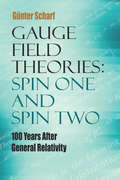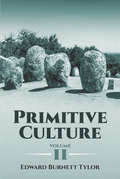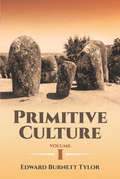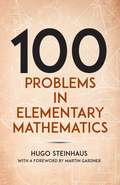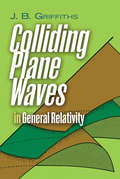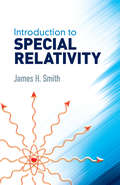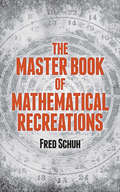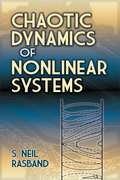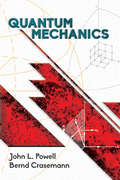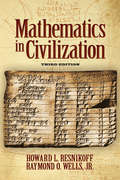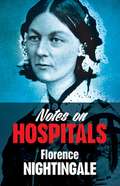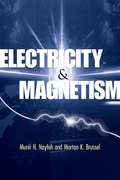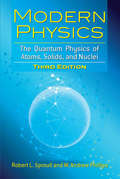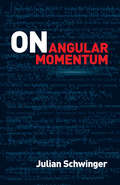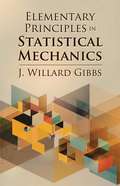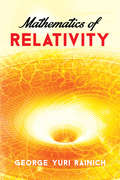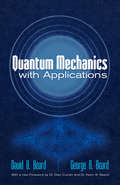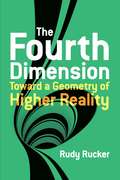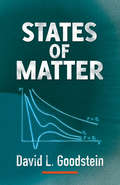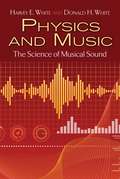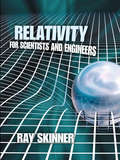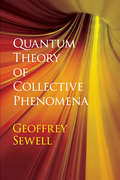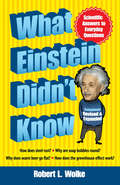- Table View
- List View
Gauge Field Theories: 100 Years After General Relativity
by Gunter ScharfOne of the main problems of theoretical physics concerns the unification of gravity with quantum theory. This monograph examines unification by means of the appropriate formulation of quantum gauge invariance. Suitable for advanced undergraduates and graduate students of physics, the treatment requires a basic knowledge of quantum mechanics.Opening chapters introduce the free quantum fields and prepare the field for the gauge structure, describing the inductive construction of the time-ordered products by causal perturbation theory. The analysis of causal gauge invariance follows, with considerations of massless and massive spin-1 gauge fields. Succeeding chapters explore the construction of spin-2 gauge theories, concluding with an examination of nongeometric general relativity that offers an innovate approach to gravity and cosmology.
The Electrical Properties of Metals and Alloys (Dover Books on Physics)
by J. S. DugdaleSuitable for advanced undergraduate and graduate students of physics, this classic volume by a prominent authority in the field provides an account of some simple properties of metals and alloys associated with electron transport. Introductory chapters examine the bulk properties of electrical resistivity, the Hall coefficient, and thermoelectric power.Author J. S. Dugdale establishes a picture of the current-carrying state of a solid and the associated electron energy states before exploring how departures from crystal perfection scatter electrons. Static imperfections and lattice vibrations receive detailed explanations before the text advances to complex scattering. Emphasis on the behavior of real materials provides readers with a physical understanding of transport properties of transition metals, resistance, and thermoelectric anomalies in dilute magnetic alloys and transport in concentrated alloys and compounds.
Primitive Culture, Volume II: Researches Into The Development Of Mythology, Philosophy, Religion, Art, And Custom, Volume 2 - Primary Source Edition (Cambridge Library Collection - Anthropology)
by Edward Burnett TylorThe first Professor of Anthropology at the University of Oxford, Edward B. Tylor, defined the term "culture" for modern readers in this groundbreaking work. Initially published in 1871, this classic two-volume study explores the full range of learned human behavior patterns in terms of the beliefs, wisdom, laws, artistic achievements, and mores that constitute a society. The formation of anthropology as a scientific discipline began with this work, which continues to exercise a profound influence on anthropologic studies. The shared history of all humans, a common ground that evolved from primitive roots, constitutes the basis for Tylor's model of development. Drawing upon a worldwide variety of beliefs, rituals, and languages, the author illustrates an all-inclusive pattern of progress. His methods inaugurated the use of statistical data in anthropology, a standard procedure today but a landmark for his time. Volume I of Primitive Culture examines social evolution, language, and myth. The focus of this second volume is animism in society, which explores the tremendous diversity of thinking related to the concepts of the soul and religion as well as the marked similarities of spiritual beliefs.
Primitive Culture Volume I
by Edward Burnett TylorUse of the term "culture" as an expression of the full range of learned human behavior patterns began with this classic two-volume work, first published in 1871. Edward B. Tylor, the first Professor of Anthropology at the University of Oxford, declared that culture is "that complex whole which includes knowledge, belief, art, law, morals, custom, and any other capabilities and habits acquired by man as a member of society." Tylor is credited with the establishment of anthropology as a scientific discipline, and his groundbreaking work was highly influential in the development of cultural evolution as the foundation for anthropologic studies. Tylor's unilinear model of development maintains that humans share a common history, evolving from a single primitive form. His studies of the languages, rituals, and beliefs of societies from around the world pioneered the use of statistical data and substantiated his view of a universal pattern of development in all cultures. Volume I of Primitive Culture focuses on social evolution, language, and myth. Volume II focuses on Tylor's interpretation of animism in society, offering details of the endlessly varied ideas and beliefs regarding the soul, spirits, and gods.
One Hundred Problems in Elementary Mathematics (Dover Books on Mathematics)
by Martin Gardner Hugo SteinhausBoth a challenge to mathematically inclined readers and a useful supplementary text for high school and college courses, One Hundred Problems in Elementary Mathematics presents an instructive, stimulating collection of problems. Many problems address such matters as numbers, equations, inequalities, points, polygons, circles, ellipses, space, polyhedra, and spheres. An equal number deal with more amusing or more practical subjects, such as a picnic ham, blood groups, rooks on a chessboard, and the doings of the ingenious Dr. Abracadabrus.Are the problems in this book really elementary? Perhaps not in the lay reader’s sense, for anyone who desires to solve these problems must know a fair amount of mathematics, up to calculus. Nevertheless, Professor Steinhaus has given complete, detailed solutions to every one of his 100 problems, and anyone who works through the solutions will painlessly learn an astonishing amount of mathematics. A final chapter provides a true test for the most proficient readers: 13 additional unsolved problems, including some for which the author himself does not know the solutions.
Colliding Plane Waves in General Relativity (Dover Books on Physics)
by J. B. GriffithsThis monograph surveys recent research on the collision and interaction of gravitational and electromagnetic waves. "This is a particularly important topic in general relativity," the author notes, "since the theory predicts that there will be a nonlinear interaction between such waves." Geared toward graduate students and researchers in general relativity, the text offers a comprehensive and unified review of the vast literature on the subject.The first eight chapters offer background, presenting the field equations and discussing some qualitative aspects of their solution. Subsequent chapters explore further exact solutions for colliding plane gravitational waves and the collision and interaction of electromagnetic waves. The final chapters summarize all related results for the collision of plane waves of different types and in non-flat backgrounds. A new postscript updates developments since the book's initial 1991 publication.
Introduction to Special Relativity (Dover Books on Physics)
by James H. SmithBy the year 1900, most of physics seemed to be encompassed in the two great theories of Newtonian mechanics and Maxwell's theory of electromagnetism. Unfortunately, there were inconsistencies between the two theories that seemed irreconcilable. Although many physicists struggled with the problem, it took the genius of Einstein to see that the inconsistencies were concerned not merely with mechanics and electromagnetism, but with our most elementary ideas of space and time. In the special theory of relativity, Einstein resolved these difficulties and profoundly altered our conception of the physical universe.Readers looking for a concise, well-written explanation of one of the most important theories in modern physics need search no further than this lucid undergraduate-level text. Replete with examples that make it especially suitable for self-study, the book assumes only a knowledge of algebra. Topics include classical relativity and the relativity postulate, time dilation, the twin paradox, momentum and energy, particles of zero mass, electric and magnetic fields and forces, and more.
The Master Book of Mathematical Recreations (Dover Recreational Math)
by Fred SchuhPraised for its "exceptionally good value" by the Journal of Recreational Mathematics, this book offers fun-filled insights into many fields of mathematics. The brainteasers include original puzzles as well as new approaches to classic conundrums. A vast assortment of challenges features domino puzzles, the game of noughts and crosses, games of encirclement, sliding movement puzzles, subtraction games, puzzles in mechanics, games with piles of matches, a road puzzle with concentric circles, "Catch the Giant," and much more. Detailed solutions show several methods by which a particular problem may be answered, why one method is preferable, and where the others fail. With numerous worked examples, the clear, step-by-step analyses cover how the problem should be approached, including hints and enumeration of possibilities and determination of probabilities, application of the theory of probability, and evaluation of contingencies and mean values. Readers are certain to improve their puzzle-solving strategies as well as their mathematical skills.
Chaotic Dynamics of Nonlinear Systems (Dover Books on Physics)
by S. Neil RasbandWritten when the young science of chaos was gaining a foothold in the scientific community, this book introduces the field's concepts, applications, theory, and technique. Suitable for advanced undergraduates and graduate students, researchers, and teachers of mathematics, physics, and engineering, the text's major prerequisite is familiarity with differential equations and linear vector spaces. Author S. Neil Rasband discusses the major models for the transitions to chaos exhibited by dynamic systems, introducing the "classical" topics and examples fundamental to the discipline. The most important routes to chaos are presented within a unified framework and supported by integrated problem sets. Topics include one- and two-dimensional maps, universality theory, fractal dimension, differential and conservative dynamics, and other subjects. The text is supplemented by a helpful glossary, references, and an index.
Quantum Mechanics (Dover Books on Physics)
by Bernd Crasemann John L. PowellSuitable for advanced undergraduates, this thorough text focuses on the role of symmetry operations and the essentially algebraic structure of quantum-mechanical theory. Based on courses in quantum mechanics taught by the authors, the treatment provides numerous problems that require applications of theory and serve to supplement the textual material.Starting with a historical introduction to the origins of quantum theory, the book advances to discussions of the foundations of wave mechanics, wave packets and the uncertainty principle, and an examination of the Schrödinger equation that includes a selection of one-dimensional problems. Subsequent topics include operators and eigenfunctions, scattering theory, matrix mechanics, angular momentum and spin, and perturbation theory. The text concludes with a brief treatment of identical particles and a helpful Appendix.
Mathematics in Civilization, Third Edition (Dover Books on Mathematics)
by Raymond O. Wells Jr. Howard L. ResnikoffSpace flight, computers, lasers, and information technology - these are but a few examples of the spectacular growth, development, and far-reaching applications of mathematics. But what of the field's past? Upon which intellectual milestones were the foundations of modern mathematics constructed? How has our comprehension of the physical universe, language, and the nature of thought itself been influenced and informed by the developments of mathematics through the ages?This lucid presentation examines how mathematics shaped and was shaped by the course of human events. In a format suited to college-level studies as well as popular reading, the book explores trigonometry, navigation, cartography, logarithms, algebra, and calculus through ancient, medieval, post-Renaissance, and modern times. Solutions to problems appear at the end of each chapter, and this edition has been newly expanded to include a supplement on events in mathematics since the 1985 publication of the first Dover edition. Acclaimed by Telegraphic Reviews as "an exceptionally good liberal arts math text," this highly readable treatment makes a technical subject vividly fascinating.
Notes on Hospitals: Being Two Papers Read Before The National Association For The Promotion Of Social Science, At Liverpool, In October 1858
by Florence NightingaleThe founder of modern nursing expressed her revolutionary ideas of hospital reform in these two essays, published in 1859 and presented the previous year at the Social Science Congress. During the Crimean War, Florence Nightingale achieved renown as The Lady with the Lamp, the tireless caretaker of wounded soldiers. Afterward, Nightingale searched Europe for innovations to help the army improve its hospital care. This report of her findings and suggestions had a profound effect on the medical community and reestablished the author as an international healthcare authority.Despite the advances in medical knowledge since Nightingale's era, her common-sense approach continues to form a solid foundation for nursing. In these essays she voices the importance of hygiene―fresh air and water, cleanliness, proper drainage, and ample light―as well as ongoing consideration for patients' feelings. Nightingale's ability to effectively articulate her ideas impressed her contemporaries and continues to influence modern readers. This volume serves as a companion to Nightingale's classic of nursing literature, Notes on Nursing: What It Is, and What It Is Not.
Electricity and Magnetism
by Dr Munir H. Nayfeh Dr Morton K. BrusselThis outstanding text for a two-semester course is geared toward physics undergraduates who have completed a basic first-year physics course. The coherent treatment offers several notable features, including 300 detailed examples at various levels of difficulty, a self-contained chapter on vector algebra, and a single chapter devoted to radiation that cites interrelationships between various analysis methods. Starting with chapters on vector analysis and electrostatics, the text covers electrostatic boundary value problems, formal and microscopic theories of dielectric electrostatics and of magnetism and matter, electrostatic energy, steady currents, and induction. Additional topics include magnetic energy, circuits with nonsteady currents, Maxwell's equations, radiation, electromagnetic boundary value problems, and the special theory of relativity. Exercises appear at the end of each chapter and answers to odd-numbered problems are included in one of several helpful appendixes.
Modern Physics: The Quantum Physics of Atoms, Solids, and Nuclei: Third Edition (Dover Books on Physics)
by W. Andrew Phillips Robert L. SproullThis introduction to the concepts and methods of quantum mechanics employs the analysis of one-dimensional problems to offer students a quantitative understanding of atomic, molecular, solid-state, and nuclear physics. Applications of these concepts and methods help answer the most intriguing questions of modern physics: What holds matter together? Holds it apart? How does the variety of chemical properties of different elements arise? How do electrons move through solids? Why do nuclei that occur in nature possess only certain combinations of protons and neutrons? The text presents meaningful problems by topic -- supplemented by ample illustrations, applications, and exercises -- that address the most intriguing questions of modern physics. Answers to selected problems appear in the appendix. Geared toward science and engineering majors, this volume is also appropriate for independent study by those who have completed a general physics course.
On Angular Momentum (Dover Books on Physics)
by Julian SchwingerA concise treatment of angular momentum by an important American physicist, this major work was first published under the auspices of the United States Atomic Energy Commission in 1952 and is finally available to a general audience of students and professionals in the field. Advanced undergraduates and graduate students of physics will particularly benefit from its teachings.One of the most prominent American physicists of the twentieth century, Julian Schwinger (1918-94) taught at Harvard, MIT, and UCLA, among other institutions. In addition to his many other awards, Schwinger, jointly with Richard Feynman and Shinichiro Tomonaga, received the Nobel Prize in Physics in 1965 for his work in quantum electrodynamics.
Elementary Principles in Statistical Mechanics: Developed With Especial Reference To The Rational Foundation Of Thermodynamics (Dover Books on Physics)
by J. Willard GibbsWritten by J. Willard Gibbs, the most distinguished American mathematical physicist of the nineteenth century, this book was the first to bring together and arrange in logical order the works of Clausius, Maxwell, Boltzmann, and Gibbs himself. The lucid, advanced-level text remains a valuable collection of fundamental equations and principles. Topics include the general problem and the fundamental equation of statistical mechanics, the canonical distribution of the average energy values in a canonical ensemble of systems, and formulas for evaluating important functions of the energies of a system. Additional discussions cover maximum and minimal properties of distribution in phase, a valuable comparison of statistical mechanics with thermodynamics, and many other subjects.
Mathematics of Relativity
by George Yuri RainichBased on the ideas of Einstein and Minkowski, this concise treatment is derived from the author's many years of teaching the mathematics of relativity at the University of Michigan. Geared toward advanced undergraduates and graduate students of physics, the text covers old physics, new geometry, special relativity, curved space, and general relativity.Beginning with a discussion of the inverse square law in terms of simple calculus, the treatment gradually introduces increasingly complicated situations and more sophisticated mathematical tools. Changes in fundamental concepts, which characterize relativity theory, and the refinements of mathematical technique are incorporated as necessary. The presentation thus offers an easier approach without sacrifice of rigor.
Quantum Mechanics with Applications
by Prof. David B Beard Kevin B Beard Prof. George B BeardThis introductory text emphasizes Feynman's development of path integrals and its application to wave theory for particles. Suitable for undergraduate and graduate students of physics, the well-written, clear, and rigorous text was written by two of the nation's leading authorities on quantum physics. A solid foundation in quantum mechanics and atomic physics is assumed.Early chapters provide background in the mathematical treatment and particular properties of ordinary wave motion that also apply to particle motion. The close relation of quantum theory to physical optics is stressed. Subsequent sections emphasize the physical consequences of a wave theory of material properties, and they offer extensive applications in atomic physics, nuclear physics, solid state physics, and diatomic molecules. Four helpful Appendixes supplement the text.
The Fourth Dimension: Toward a Geometry of Higher Reality
by Rudy RuckerThis is the definitive popular exploration of what the fourth dimension means, both physically and spiritually. Mathematician and science-fiction novelist Rudy Rucker takes readers on a guided tour of a higher reality that explores what the fourth dimension is and what it has meant to generations of thinkers. The exciting and challenging journey is enhanced by more than 200 illustrations and a host of puzzles and problems (with answers)."This is an invigorating book, a short but spirited slalom for the mind." -- Timothy Ferris, The New York Times Book Review "Highly readable. One is reminded of the breadth and depth of Hofstadter's Gödel, Escher, Bach." -- Science"Anyone with even a minimal interest in mathematics and fantasy will find The Fourth Dimension informative and mind-dazzling... [Rucker] plunges into spaces above three with a zest and energy that is breathtaking." -- Martin Gardner "Those who think the fourth dimension is nothing but time should be encouraged to read The Fourth Dimension, along with anyone else who feels like opening the hinges of his mind and letting in a bit of fresh air." -- John Sladek, Washington Post Book World"A mine of mathematical insights and a thoroughly satisfying read." -- Paul Davies, Nature Magazine
States of Matter (Dover Books on Physics)
by David L. GoodsteinThis unique overview by a prominent CalTech physicist provides a modern, rigorous, and integrated treatment of the key physical principles and techniques related to gases, liquids, solids, and their phase transitions. No other single volume offers such comprehensive coverage of the subject, and the treatment consistently emphasizes areas in which research results are likely to be applicable to other disciples.Starting with a chapter on thermodynamics and statistical mechanics, the text proceeds to in-depth discussions of perfect gases, electrons in metals, Bose condensation, fluid structure, potential energy, Weiss molecular field theory, van der Waals equation, and other pertinent aspects of phase transitions. Many helpful illustrative problems appear at the end of each chapter, and annotated bibliographies offer further guidance.
Problems in Quantum Mechanics: Third Edition
by D. Ter HaarA wide-ranging collection of problems and solutions related to quantum mechanics, this text will be useful to students pursuing an advanced degree in physics. Topics include one-dimensional motion, tunnel effect, commutation relations, Heisenberg relations, spreading of wave packets, operators, angular momentum, spin, central field of force, motion of particles in a magnetic field, atoms, scattering, creation and annihilation operators, density matrix, relativistic wave equations, and many other subjects.Suitable for advanced undergraduates and graduate students of physics, this third edition was edited by Dirk ter Haar, a Fellow of Magdalen College and Reader in Theoretical Physics at the University of Oxford. This enlarged and revised edition includes additional problems from Oxford University Examination papers. The book can be used either in conjunction with another text or as advanced reading for anyone familiar with the basic ideas of quantum mechanics. 1975 edition.
Physics and Music: The Science of Musical Sound (Dover Books on Physics)
by Donald H. White Harvey E. WhiteThis foundational text is written for students who want to go beyond the perceptual stage of music to learn how musical sound is created and perceived. It surveys a wide range of topics related to acoustics, beginning with a brief history of the art and science of music. Succeeding chapters explore the general principles of sound, musical scales, the primary ways in which sound can be generated, the characteristics of instruments, the use of mechanical and electronic recording devices, hi-fi stereophonic and quadraphonic sound, the design of electronic musical instruments, and architectural acoustics.Comprehensive yet accessible, Physics and Music includes over 300 diagrams, photographs, and tables. Each chapter concludes with questions, problems, and projects, in addition to references for further study. 1980 edition.
Relativity for Scientists and Engineers (Dover Books on Physics)
by Ray SkinnerAn ideal choice for undergraduate students of science and engineering, this book presents a thorough exploration of the basic concepts of relativity. The treatment provides more than the typical coverage of introductory texts, and it offers maximum flexibility since many sections may be used independently, in altered order, or omitted altogether. Numerous problems -- most with hints and answers -- make this volume ideal for supplementary reading and self-study.Nearly 300 diagrams illuminate the three-part treatment, which examines special relativity in terms of kinematics and introductory dynamics as well as general relativity. Specific topics include the speed of light, the relative character of simultaneity, the Lorentz transformation, the conservation of momentum and energy, nuclei and fundamental particles, the principle of equivalence and curved space-time, Einstein's equations, and many other topics.
Quantum Theory of Collective Phenomena (Dover Books on Chemistry)
by Prof. G. L. SewellThis systematic approach to the quantum theory of collective phenomena is based principally on the model of infinite systems. Suitable for advanced undergraduates and graduate students of physics and chemistry, the three-part treatment begins with an exposition of the generalized form of quantum theory of both finite and infinite systems. Part II consists of a general formulation of statistical thermodynamics, and the final part provides a treatment of the phenomena of phase transitions, metastability, and the generation of ordered structures far from equilibrium. "An excellent and competent introduction to the field … [and] … a source of information for the expert." — Physics Today"This a book of major importance…. I trust that this book will be used as a basis for the teaching of a balanced, modern and rigorous course on statistical mechanics in all universities." — Bulletin of the London Mathematical Society"This is one of the best introductions to the subject, and it is strongly recommended to anyone interested in collective phenomena." — Physics Bulletin "The book may be recommended for students as a well-balanced introduction to this rich subject and it can serve as a useful handbook for the expert." — Journal of Statistical Physics
What Einstein Didn't Know: Scientific Answers to Everyday Questions
by Robert L. WolkeDiscover how cricket chirps can tell us the temperature, why you can't unburn a match, why ice floats, and a host of mysteries of modern living -- including some riddles that maybe even Einstein couldn't solve. From the simple (How does soap know what's dirt? How do magnets work? Why do batteries die?) to the more complex (Why does evaporation have a cooling effect? Where does uranium get its energy?), this book makes science more understandable and fun. Author Robert Wolke provides definitive and easy-to-comprehend explanations for things that we take for granted, like the illumination behind neon signs and the mysteries of beverage carbonation. Wolke also dares readers to explore and conduct their own experiments with food, kitchen utensils, and common household products. This fifteenth anniversary edition of his bestselling popular science classic has been completely revised and expanded.
